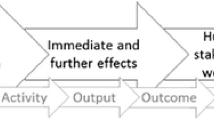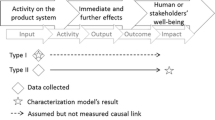Abstract
Background, aims, and scope
Social Life Cycle Assessment (SLCA) is a tool assessing the social aspects of products and services. This article is a step forward from the Guidelines and wishes to clarify the different impact assessment (IA) methods covered in the Guidelines and how these different methods would provide different types of information regarding the social aspects of the product system.
Methods
The outcomes resulting from different sLCIA methods are discussed through the analysis of three methods covered by the Guidelines for SLCA (UNEP 2009): the Taskforce’s method, Hunkeler’s (2006) and Weidema’s (2006). In order to highlight the different outcomes, we analyze the “nature” of the indicator results, the sources of the stressors, and the way the IA results are linked to the product system.
Results
Different results are provided depending on the sLCIA approach used. We stress that the use of impact pathways allows the assessment of social impacts. The Taskforce’s method, which compares the state of the dimensions of the social context of the product system with international consensus, assesses “social performances.” Regarding the sources of the stressors, the analysis needs to look at other levels than the unit process to capture the social issues. Finally, two approaches are used to connect the indicator results to the product system: one carrying the quantitative link between the inventory indicator and the functional unit all the way to the IA result through impact pathways, and the other, weighting the IA results according to the relative importance of an activity variable.
Discussion
The different features of the sLCIA methods result in different outcomes. Depending on the sources of the stressors, different levels are assessed. When the stressors are collected at an organizational level, e.g., country, sector, or enterprise, the unit assessed becomes the social context, which can be called “context units” parallel to the unit processes. SLCIA methods will also provide different outcomes depending on the characterization models used in the analysis: social impacts versus social performances. Finally, the difference between the outcomes according to the approaches used to link the IA results to the product system will require further reflections.
Conclusions
Two types of sLCIA are covered by the Guidelines. One uses Performance Reference Points allowing the evaluation of the relative position of the state of a dimension of a context unit in reference to an international consensus. The second one, closer to LCA, assesses the social impacts derived from the technical nature of the processes, through the use of impact pathways.
Recommendations and perspectives
Choosing between the feasibility of deriving social impacts from social variables through impact pathways or assessing a broader set of social issues through the use of semiquantitative indicators is an ongoing issue and requires further research. Currently, the choice of sLCIA methods is informed by the availability of the characterization models and the indicators.

Similar content being viewed by others
Notes
i.e., impact pathways, “performance reference points,” etc.
The Taskforce’s method represents ideas that were put forwards within the Taskforce and accepted by the group.
We use “stressor” to qualify the element of pressure, the elementary flow and the inventory indicator according to the implicit utilization by (Jorgensen et al. 2008): “However, connecting the stressors that create the impacts and the Areas of Protection requires that the impact pathway is established. […] Because midpoint indicators are closer to the stressors and also more understandable for decision makers […]”
The sociosphere refers herein to the social pillar of the three pillars of sustainable development. If LCA assesses the impacts occurring in the environmental sphere, the SLCA assesses the sociosphere through different stakeholders and issues of concern.
The indicators are presented in the form of “methodological sheets” available at www.lcinitiative.unep.fr
References
Aissani L (2008) Intégration des paramètres spatio-temporels et des risques d’accident à l’Analyse du Cycle de Vie : Application à la filière hydrogène énergie et à la filière essence. Thèse de doctorat présentée pour obtenir le grade de Docteur de l’Ecole Nationale Supérieure des Mines de Saint-Etienne
Andrews E, Lesage P, Benoît C, Parent J, Norris G, Revéret J-P (2009) Life cycle attribute assessment—case study of Quebec tomatoes. J Ind Ecol 13(4):565–578
Dreyer LC, Hauschild MZ, Schierbeck J (2006) A framework for social life cycle impact assessment. Int J Life Cycle Assess 11(2):88–97
Gauthier C (2005) Measuring corporate social and environmental performance: the extended life-cycle assessment. J Bus Ethics 59:199–206
Griesshammer R, Benoît C, Dreyer LC, Flysjö A, Manhart A, Mazijn B, Méthot A-L, Weidema B (2006) Feasibility study: Integration of social aspects into LCA. http://jp1.estis.net/includes/file.asp?site=lcinit&file=2FF2C3C7-536F-45F2-90B4-7D9B0FA04CC8. Accessed Nov 2009.
Hunkeler D (2006) Societal LCA methodology and case study. Int J Life Cycle Assess 11(6):371–382
ISO 14044 (2006) Environmental management—Life cycle assessment—Requirements and guidelines
Jorgensen A, Le Bocq A, Nazarkina L, Hauschild M (2008) Methodologies for social life cycle assessment. Int J Life Cycle Assess 13(11):96–103
Kloepffer W (2008) Life cycle sustainability assessment of products. Int J Life Cycle Assess 13(2):89–95
Norris G (2006) Social impacts in product life cycle: towards life cycle attribute assessment. Int J Life Cycle Assess 11(special issue 1):97–102
Parent J (2009) Élaboration d’un modèle d’évaluation de la caractéristique ‘salaires’ en Analyse Sociale du Cycle de Vie. Mémoire présenté comme exigence partielle de la Maîtrise en sciences de l’environnement, Université du Québec à Montréal
Spillemaeckers S, Vanhoutte G (2006) A product sustainability assessment. In: Jonker J, de Witte M (eds) Management models for corporate social responsibility. Springer, Heidelberg, pp 257–264
Standing G (2003) The decent work enterprise: worker security and dynamic efficiency. International Labour Office, Geneva
UNEP (2009) Guidelines for social life cycle assessment of products. United Nations Environment Program, Paris
Vanclay F (2003) International principles for social impact assessment. Impact Assess Proj Apprais 21:5–12
Weidema B (2006) The integration of economic and social aspects in life cycle impact assessment. Int J Life Cycle Assess 11(Special Issue 1):89–96
Acknowledgement
The authors wish to thank all the Taskforce members for the constructive exchanges without which the reflections shared in this paper would never have emerged.
Author information
Authors and Affiliations
Corresponding author
Additional information
Responsible editor: Tom Swarr
Rights and permissions
About this article
Cite this article
Parent, J., Cucuzzella, C. & Revéret, JP. Impact assessment in SLCA: sorting the sLCIA methods according to their outcomes. Int J Life Cycle Assess 15, 164–171 (2010). https://doi.org/10.1007/s11367-009-0146-9
Received:
Accepted:
Published:
Issue Date:
DOI: https://doi.org/10.1007/s11367-009-0146-9




